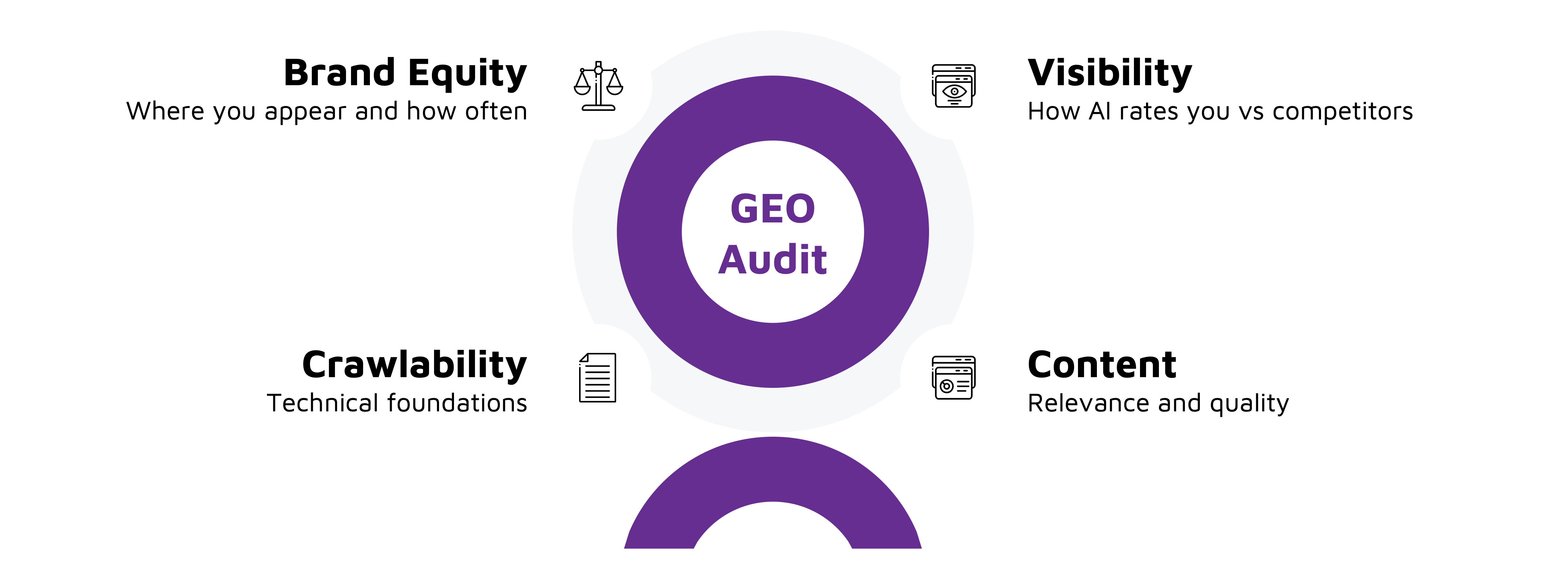AI-referred traffic converts at 4.4x the rate of traditional organic search (Semrush), and 68% of consumers now use AI for research and summarization (Bain & Company). But your #1 Google rank won't guarantee you AI recommendations. How can you get them without wasting resources? This article presents the five-step framework for creating strategic clarity.
AI is reshaping the entire digital path to purchase. Whether you call the work generative engine optimization (GEO), answer engine optimization (AEO), or AI search optimization (AI SEO), what matters is getting AI tools to recommend your offerings when people ask for guidance. There's no shortcut. Strategic execution separates brands that win citations from those that waste budget.
The Tactics Trap: Two Ways to Waste Your GEO Budget
You can ask ChatGPT how it evaluates products. It'll point to structured content, schema markup, and authoritative external sources. Dozens of articles explain GEO tactics.
What those articles can't tell you — and what ChatGPT doesn't know — is which tactics actually matter for your business, which battles you can realistically win, and what your organization can execute well. New moves made without strategic foundation typically play out in two predictable ways:
Optimize everywhere, win nowhere
AI platforms are proliferating rapidly. ChatGPT, Perplexity, Amazon Rufus, Google AI Overviews, Walmart Sparky… the list goes on. Each platform serves different needs and relies on different sources. But which ones do your buyers actually use for purchase decisions? Trying to optimize for every platform spreads resources impossibly thin. You need focused effort on the platforms that actually drive revenue.
Build authority everywhere, influence nowhere
Wikipedia, review sites, industry publications, business directories — the list of "authority sources" seems endless. But which sources do AI models trust in your market? Authority in supplements is not authority in beauty products, let alone professional services. Trying to build authority everywhere wastes budget.
Brands succeeding with GEO either learned these lessons the hard way or started with strategic clarity. Here's the framework:
The AI Search Strategy Sequence
Strategic GEO requires moving through five distinct steps in order. Skip one and the others fail.
 The framework that separates strategic GEO from expensive guessing.
The framework that separates strategic GEO from expensive guessing.
Here's why each step matters:
Step 1: Decide Where to Play
Many brands approach GEO wanting to win everywhere: on every attribute, on every query, in every segment. But challengers face an uphill battle. If incumbents have spent years building Wikipedia presence, review site dominance, and media mentions, you won't displace them on their core positioning through content optimization alone.
Strategic clarity begins with honest assessment of where you can realistically compete. This analysis answers three questions:
- Which attributes should you own in AI's "mind"? AI models categorize offerings based on attributes. Narrow, defensible attributes create competitive advantage. If you're a challenger brand where established players dominate broad queries, you won't win "What's the best protein powder?" citations quickly — that's heavily contested territory. You have better odds with "What's the best whey isolate protein?" But your strongest competitive position is likely at the narrow end: "What's the best whey isolate protein for lactose intolerance?"
The principle applies across sectors. In OTC medications, fighting for "What's the best ibuprofen?" means battling Advil and Motrin's decades of authority. But "What's the best ibuprofen for sinus headaches?" might be wide open. For staffing services, "What's the best recruiting firm?" faces the same authority problem, while "What's the best staffing agency for temporary aerospace engineers in the Pacific Northwest?" could be winnable.
The work is identifying which attributes align with your actual competitive strengths rather than aspirational positioning. - Which queries represent purchase intent? Not all queries are equally valuable. "What is melatonin?" generates massive search volume but converts poorly. "What’s the best melatonin supplement for shift workers?" represents a potential buyer much closer to purchase with specific requirements.
Query prioritization maps business value against competitive reality — connecting queries to revenue, identifying strategic opportunities versus vanity metrics, and assessing which you can realistically win given your current authority position. - Where can you actually compete and win? A realistic assessment of your competitive position determines which battles are winnable versus which waste resources fighting well-positioned competitors. This involves examining whether your offerings have verifiable properties that AI models can confirm, whether you own specific buyer segments where you're already recognized, and whether there are emerging categories where established competitors haven't built authority yet.
For example, a regional American pharmacy chain competing for "What’s the best online pharmacy?" against CVS and Walgreens faces long odds. But "What’s the best compounding pharmacy in Austin?" or "Give me the best specialty pharmacy for rare disease medications" might be winnable with strong local authority signals.
 Narrow positioning creates competitive advantage in AI search
Narrow positioning creates competitive advantage in AI search
Step 2: Understand Your Current State
Knowing where you want to compete doesn't tell you where you stand today. A proper GEO audit assesses your current competitive position across four key dimensions:
- Brand equity: Where do you appear across AI platforms and how often? Every AI platform pulls from different sources. Visibility analysis identifies which platforms already cite you, for which queries, and in what context.
- Visibility: How do AI models rate your brand against competitors? Are platforms recommending your brand, and how — positively, neutrally, or with caveats? How do your citations compare to competitors across the queries you identified as winnable?
- Crawlability: Are technical foundations preventing AI models from understanding your content? Schema markup, good crawlability, and structured data help AI models understand and trust your content. Technical gaps may prevent citations even when underlying product information is strong.
- Content: Is your content comprehensive and AI-ready? AI models evaluate whether your content answers common buyer questions with the depth and detail needed to confidently cite you. Gaps in information quality may prevent citations even when technical foundations are solid.

Without baseline measurement across all these dimensions, you're optimizing blind.
Step 3: Define How You Win
Generic "GEO best practices" don't cover market-specific dynamics that determine which brands get cited. Step 3 reveals the rules of your competitive game. It requires moving beyond manual queries to systematic analysis, using the right tools to map citation patterns at scale, and identifying what AI models actually value in your market:
- What factors drive AI citations in your market? Citation drivers vary dramatically. For supplements, third-party testing certifications might dominate. For OTC medications, active ingredient transparency might matter most. For beauty products, dermatologist endorsements could be critical. Driver analysis identifies which factors actually influence AI citation behavior in your market.
- Which sources do AI models trust in your market? The sources AI models weight heavily vary by market. Understanding which sources matter in yours determines where you need to establish presence. Amazon reviews might drive citations for household products but not premium skincare. Reddit discussions might influence supplement recommendations but not baby food. For B2B services, industry analyst reports and case study databases might matter more than review platforms.
- What content structure gaps prevent AI models from citing you? AI models favor content structured in lists, clear headings, tables, Q&As, and declarative statements. But different offerings have different citation patterns. AI might favor nutritional tables for food products, ingredient transparency for supplements, usage instructions for OTC medications, or case study formats with measurable outcomes for professional services. Content structure analysis identifies gaps between how your content is organized and what AI models prioritize in your market.
Step 4: Prioritize and Execute
Some GEO initiatives deliver results in weeks with minimal coordination. Others require months of cross-functional effort. Some initiatives unlock others; you can't build effective authority before your content structure supports citation. A well-designed roadmap translates competitive intelligence into sequenced action:
- Quick wins: High-impact actions your team can execute now. These initiatives require limited coordination and deliver measurable results quickly. They might include restructuring high-priority product pages, implementing schema markup, or adding AI-optimized Q&As for key products. Quick wins create momentum and build organizational support for longer-term initiatives.
- Long-game moves: Authority-building efforts with compounding returns. Establishing presence in trusted third-party sources, building comprehensive coverage in industry publications, or developing original research all require sustained effort. These investments compound over time. Your roadmap identifies which long-term plays align with your competitive positioning and which your organization can realistically sustain.
Step 5: Track Progress
GEO impact may take months to materialize. Unlike traditional SEO where ranking changes appear within weeks, authority building and content restructuring show results gradually. Without systematic tracking, you won't know whether your strategy is working until it's too late to course-correct efficiently.
Step 5 involves ongoing measurement across two dimensions:
- Citation frequency for your prioritized queries. Regularly measure whether you're appearing more frequently in AI recommendations for strategically valuable queries, whether increased citations are driving AI-referred traffic, whether that traffic converts, and whether you're winning citations for queries that generate revenue.
- Interpretation of what changed and why. Citation frequency may fluctuate for reasons beyond your GEO efforts, e.g. platform algorithm changes, competitor actions, or seasonal variations. The goal is identifying signal from noise and making strategic adjustments based on what’s working.
Be the Brand AI Can’t Ignore
Most brands getting into GEO will spend the next 12 months optimizing randomly. They will be restructuring content without knowing which queries matter and building authority on platforms that don’t matter.
Smart brands will spend the same 12 months focused on winnable positions, grounded in competitive reality, and with measures of what’s working.
The stakes are rising quickly. AI platforms are moving beyond recommendations to integrated commerce. ChatGPT now includes "Buy" buttons that enable instant purchase without leaving the interface. But people can't buy what they can't discover. Recommendation comes first.
Which path you take doesn't depend on budget or team size. It depends on starting with strategic assessment before tactical execution.
Ready to win your market's AI path to purchase?
Contact us for a GEO audit that reveals where you can realistically compete.







